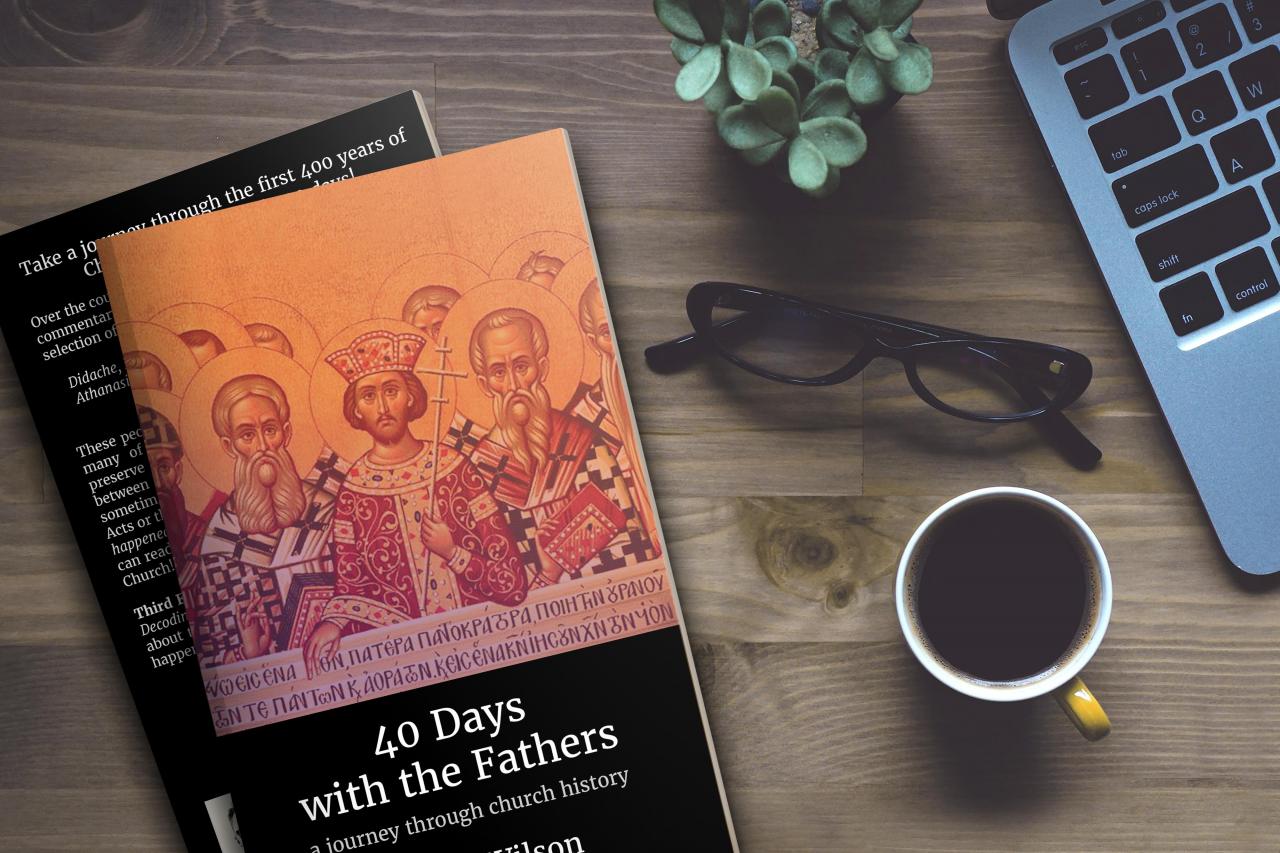Blog Group: Early Church History (6 posts)
The Real St. Nicholas: A Man of Virtue, Not Violence
Luke J. Wilson | 07th December 2024 |
Early Church History
When we think of St. Nicholas, two contrasting images often emerge: the cheerful, gift-giving Santa Claus and the fiery bishop who supposedly punched Arius at the Council of Nicaea. The latter story, popularised through memes and tales of “righteous anger,” portrays Nicholas as a defender of truth through violence. But how much of this tale is rooted in fact?
St Nicholas of Myra slapping Arius at the Council of Nicaea.Fresco from the Soumela Monastery (Turkey)
The truth is both simpler and more profound: St. Nicholas embodied the teachings of Christ, not through impulsive acts of aggression, but through a life of love, generosity, and devotion.
Separating Fact from Legend
The infamous story of St. Nicholas striking Arius comes from hagiographies written around 1000 years after the Council of Nicaea in 325 AD. These accounts describe Nicholas, angered by Arius’s denial of Christ’s divinity, delivering a blow during the debate. However, contemporary records do not corroborate this tale. Even Nicholas’s attendance at the council is uncertain, as his name is absent from the earliest participant lists.
The story likely arose as a dramatic embellishment to highlight his zeal for orthodoxy. Over time, it has been embraced as a symbol of righteous indignation.
Roger Pearse, of the Tertullian Project, summarises this legend succinctly:
To summarise again: there is no ancient evidence whatever that St Nicholas punched or slapped Arius at the First Council of Nicaea. The story is not found in any text before the late 14th century, and even that one mentions only “a certain Arian”. In the next two centuries the legend mutates into Nicholas slapping Arius; and is then disseminated in works of popular fiction, and by the paintings of icons. It has no historical basis whatever.
The Problem with Celebrating the Slap
In a culture that often glorifies bold, confrontational responses, the idea of a saint who resorts to physical violence can seem appealing. I...
Did St. Nicholas Really Slap Arius?
Luke J. Wilson | 21st November 2023 |
Early Church History
It’s nearly Christmas time again, and like clockwork, the internet memes come out all over social media about Saint Nicholas giving the heretic Arius a slap across the face at the Council of Nicaea!
As it’s almost the end of November and coming up soon is the feast day of St. Nicholas on December 6th, the original inspiration behind Santa Claus, I thought I’d address this long-standing myth about Nicholas of Myra (present-day Demre, Turkey), the fourth century bishop.
St. Nicholas is often humorously portrayed in social media memes which playfully recount the infamous incident during the Council of Nicaea when the good bishop, provoked by Arius’s blasphemies, supposedly delivered him a slap across the face!
Memes abound about St Nicholas and Arius
While some of these memes offer undeniable amusement, they starkly contrast with the conventional image of Santa Claus — known for his jovial and indulgent nature — as well as the expected decorum of a bishop and leader in the Church. Moreover, the sentiment challenges the teachings of Jesus on how to deal with our enemies. Jesus advocated for practices such as loving and praying for your enemies, turning the other cheek (Mt 5:38–45), overcoming evil with good (Rom 12:21), being gentle and not violent (1 Tim 3:3), avoiding quick-temperedness (Titus 1:7), and recognising that a soft answer turns away wrath (Prov 15:1).
In this time marked by safe spaces, trigger warnings, and microaggressions, the straightforward honesty and tough demeanour attributed to St. Nicholas in these memes may resonate with those who appreciate a departure from the perceived niceties of modern discourse. The image of St. Nicholas allegedly striking Arius can be seen as a politically incorrect rebuke to what some Christians might see as the Church or society being too “soft” nowadays.
Historical Basis
However, historical inaccuracies abound in this narrative. The story lacks credibility, as historical records of ...
Using AI to bring the Early Church to the modern age!
Luke J. Wilson | 14th October 2023 |
Early Church History
Hello everyone, I've created and trained some AI chatbots on the writings of the Apostolic Fathers!
You can ask them anything about the authors, the texts, topics, or quotes.
Give it a try and see what you think: Apostolic Fathers Chatbot | Patristics.info
I've also made Irenaeus into an AI so you can go and have a chat with him about his works Against Heresies. The bot 'thinks' it is Irenaeus too, so you can ask it personal things as though you were talking to Irenaeus: AI Irenaeus | Patristics.info
And finally, introducing AI John Chrysostom as a similar AI which acts as the person so you can ask it questions in a more natural way: AI John Chrysostom | Patristics.info
The Chrysostom AI has been trained on the following works: On the Priesthood, Ascetic Treatises, plus select Homilies and Letters. So you can get a wider range of information and discussion out of this one.
Feel free to suggest any others you'd like to see in the comments!...
A Journey Through Church History
Luke J. Wilson | 31st January 2022 |
Early Church History
After many, many months of working on this in between COVID and other “life events” that kept me busy, I’ve finally released the Third Edition of my book, 40 Day With the Fathers: A Journey Through Church History!
The Third Edition includes: a foreword by Paul Pavao (author of Decoding Nicea), updated content and also a new chapter about the Council of Nicaea explaining what did (and didn’t) happen there.
“I cannot imagine there is a better way to get familiar with 350 of the most important years of church history in seven hours spread over 40 days.” — Paul Pavao, author of Decoding Nicea
If you are unfamiliar with my previous editions and what this book is about, here’s the blurb and some quotes from reviewers to give you an overview of its content:
Take a journey through the first 400 years of Church History in only 40 days!
Over the course of this reading plan you will read extracts and commentary on 23 different early Church texts from a selection of some of the most influential Church Fathers:
Didache, Diognetus, Polycarp, Ignatius, Justin Martyr, Cyprian, Athanasius, Cyril of Jerusalem, Ambrose of Milan, and Leo the Great.
These people who came before us, those great men of faith, many of whom suffered persecution and martyrdom to preserve the Church and Christ’s mission, bridge the gap between the Bible and the present day. They fill the void we sometimes wonder about when we get to the end of reading Acts or the Epistles and think, “what happened next?” or “what happened to the Ephesian church after Paul left?” — well now you can read for yourself and see how God continued to grow His Church!
Praise for 40 Days with the Fathers:
“Timeless truths still for today” — ⭐⭐⭐⭐⭐
“Insightful and captivating” — ⭐⭐⭐⭐⭐
“[This book] will round out your knowledge and help you become a better teacher.” — ⭐⭐⭐⭐⭐
“If you are a pastor or church leader, I highly recommend this book for ...
Did the Early Church invent the Trinity?
Luke J. Wilson | 04th January 2022 |
Early Church History
The doctrine and concept of the Trinity is encapsulated in Matthew 28:19, where Jesus instructs the apostles: “Go therefore and make disciples of all nations, baptizing them in the name of the Father and of the Son and of the Holy Spirit”. John, who was very close to Jesus and obviously knew him well, alludes to this teaching frequently in his Gospel, too. For example: John 1:1; John 8:58; John 10:30; and John 10:38.
Yet, despite this, and numerous other examples throughout the New Testament which point towards the threefold nature of God, plenty of myths and legends abound online and in books which state that the divinity of Jesus (and therefore the Trinity) were invented at the Council of Nicaea.
But any serious reader of Church History will see and know that that is complete nonsense. Christians have recognised the divinity of Jesus since the earliest times, even if they didn’t use the word “Trinity”.
First use of the word “Trinity”
The word Trinity was first used as early as A.D. 170 by Theophilus of Antioch, a Patriarch of Antioch, when writing about the creation account and how it relates to the nature of God:
In like manner also the three days which were before the luminaries, are types of the Trinity, of God, and His Word, and His wisdom. And the fourth is the type of man, who needs light, that so there may be God, the Word, wisdom, man. — Theophilus, Of the Fourth Day, Chapter XV
Then in the early third century, around A.D. 208–210, Tertullian was the first to use “Trinity”, “person”, and “substance” to explain that the Father, Son and Holy Spirit:
The numerical order and distribution of the Trinity they assume to be a division of the Unity … yet of one substance, and of one condition, and of one power, inasmuch as He is one God, from whom these degrees and forms and aspects are reckoned, under the name of the Father, and of the Son, and of the Holy Ghost … they are susceptible of number without division … whic...
Great Lent: The Season of Fasting
Luke J. Wilson | 13th February 2016 |
Early Church History
Fasting
A spiritual and physical discipline
If you are looking for a Lenten reading plan, make sure to check out my book, 40 Days with the Fathers: A Journey Through Church History, which will take you through the first 400 years of church history in forty days!
Lent is upon us once again (according to Western tradition), and so I thought it’d be good to write something on the discipline of fasting, which is often neglected or overlooked in many Protestant churches.
And much like any major holiday, there is the usual arguments and accusations about how it's all just pagan festivities with a "Christian mask". Easter is no different, and usually gets hit the hardest over its so-called "pagan roots" or Lent being some "invention of the Catholic Church".
So, this year I decided to look into it a little, since I like to try and observe Lent, and it turns out that much of the accusations against Easter and Lent are nonsense and misinformation.
A 40 day fast prior to Easter has been a long established practice within the Church dating back to within the first century. This is well established from ancient letters we still have available, such as from Irenaeus:
For some consider themselves bound to fast one day, others two days, others still more. In fact, others fast forty days ... And this variety among observers [of the fasts] did not have its origin in our time, but long before in that of our predecessors.
–Irenaeus (c.180)
See here he notes that this was a practice passed onto them by their "predecessors", a term often used in conjunction with the Apostles themselves, or those which immediately came after them, putting the origins of this Lent fast much earlier than when Irenaeus wrote in 180.
While there is a tentative link to the name "Easter" and a old Saxon goddess, the older root of the word simply means "East" or "dawn" in some other renditions, according to an Etymological Dictionary:
Ester and oster, the early English and German words, bot...






